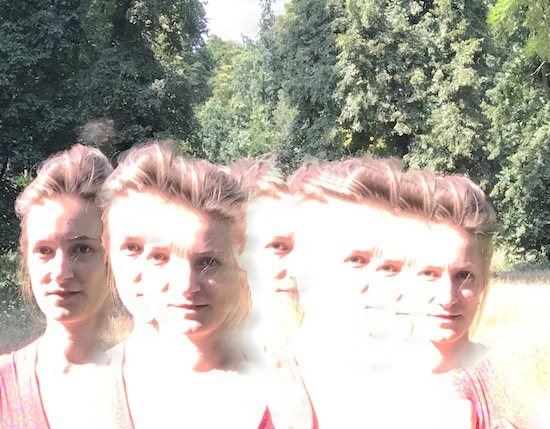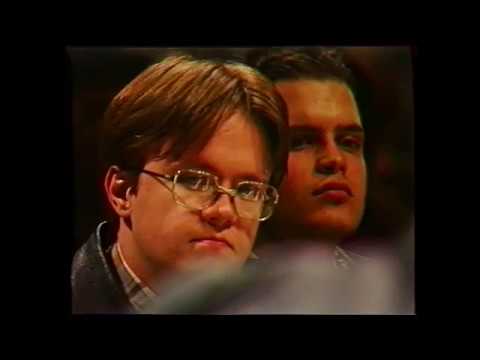Catherine Lamb
Let me be brutally honest with you: most of this month I have barely listened to anything apart from Patten’s Sade re-edit I bought for a quid, and the latest Oscar Powell (which might be more correctly called a series of folders than a release in the traditional sense). He seems to be aiming for nothing less than an escape from linear music. Why have a beginning middle and an end when you can build a site with fragmented audio that plays in a squidged and slammed together sequence of your own devising? It is infinite if required.
On more material concerns, all my records are now in boxes in preparation for a home move that may or may not happen. The CDs are stacked and packed, the tapes in a box alongside odd-shaped audio objects: a DIY cardboard music box sent in to The Wire ten years ago; a copy of William Basinski’s first album someone reissued on reel-to-reel I will likely never play; a double-cassette mix tape with pasted newspaper cover and stand-up interludes my friend Stephen made for me when I was 18.
Packing everything away is the worst time to try and pack everything away – as soon as I started taking things off the shelf I wanted to listen to everything. Eliane Radigue CD box sets; Folkways CD-Rs; cassettes of Illusion of Safety and Blue Sabbath Black Fiji; Sound Stream 12”s. I stuck on my favourite 12” – a very flimsy copy of Anthony “Shake” Shakir’s ‘Mood Swing’, a track that turns around an ESG sample and has a drop that hangs for an ecstatic second too long – it drives me wild every time.
I also found my 2004 iPod tucked away on a shelf behind some nice pieces of wood. If it switches on it contains a perfectly preserved DJ set circa 2006 – heinous amounts of blog house and Kitsune Maison mixes. Maybe I should send it straight to the Pitt Rivers Museum to be placed in a cabinet of Ed Banger ephemera.
George Lewis – Rainbow Family
(Carrier)
I recently picked up the American composer and trombonist George Lewis’s first ever solo record – The George Lewis Solo Trombone Record – after realising I didn’t have enough trombones going on in my record collection. There is something deeply enjoyable about the timbre and dynamics of a trombone, and Lewis’ boldly unaccompanied playing takes my breath away. He was only in his 20s when it was recorded. Anyway, skip forward to 1984 and this under appreciated moment in computer music history, where Lewis coded and built a system to improvise with people including double bass player Joelle Landre, Derek Bailey, Steve Lacy, and others. These ‘virtual orchestra’ performances were called Rainbow Family (precursors to his later Voyager virtual orchestra), and three networked Apple II computers ‘performed’ through three Yamaha DX-7 synthesizers. When the human musicians played, the computers analysed it, and responded.
The results are charming and distinctly odd – there is something uncanny, almost shred-like, about the dissonant ripples and plinks. It was a huge innovation at the time – Lewis writes in the sleevenotes that this was probably the first commission at IRCAM for microcomputers, and the DX-7 was brand new. No streaming on Bandcamp at time of writing, but here’s the link, and above is a live video.
Antonina Nowacka – Lamunan
(Mondoj)
Antonina Nowacka is one half of Polish duo WIDT. Lamunan is a solo vocal album, of recordings made in the geological outboard of a cave near a Javanese volcano, which she later assembled in a Polish fortress. It is wordless, echoing, ancient music, something brand new and impossibly old. Its simplicity makes it sing – the uncomplicated appeal of hearing one’s own voice echoed by the pre-human shapes of the earth.
Rian Treanor – File Under UK Metaplasm
(Planet Mu)
Squelchy, salty, all acid, no fat, these are melon-twisting computer music workouts by Rian Treanor (son of Mark Fell). Much hype in certain circles for this lad, and this (on Planet Mu) makes it all absolutely warranted. File Under UK Metaplasm came together thanks to Nyege Nyege’s Boutique Studio in Kampala, where he got schooled on singeli production processes, and then tweaked the resulting productions and tested them while in Japan on some powerful sound systems. He says he’s interested in how far you can push dance music "before it’s just like – no," and here, it’s very much still a massive yes.
Maarja Nuut & Sun Araw – Fantasias For Violin & Guitar
(MIDA)
When each day is a new shit show, very little can cheer me like the rambunctious ploops and twangs of Cameron Stallones. Here he plays with Estonian violinist & singer Maarja Nuut, on a release for a new label out of Talinn called MIDA, which grounds his psychedelic space jangle for a more reflective and serene listen. Her playing on a track like ‘Stasis Particle’ performs a metamorphosis between voice and strings, in liquid flux between the two instruments. It’s recorded live, and there is an openness to their playing together I really love. It is an album that feels familiar, but different.
Raven Chacon – An Anthology Of Chants Operations
(Ouidah)
In my feed this month a release in a white triangular sleeve popped up marked with a golden O, an irresistible object and the second release on a new label called Ouidah, sibling to the excellent Blume Editions. I snagged it on Soundohm, then emailed Blume to ask what the label was about. Turns out these things – Soundohm, Blume, and Ouidah are all run by the same person – Fabio.
The album is by Raven Chacon, a composer, performer and installation artist from Fort Defiance, Navajo Nation. He has been composing for two decades, and has studied with James Tenney, Morton Subotnik and Wadada Leo Smith. This new record collects nine pieces that span field recording, chance composition, aeolian instruments, drones, improvisation, and pieces made with antlers and sheets of glass. It is this breadth in sound source that gives his body of work a really distinctive shape and mood, whether it’s microtonal electronics or assemblage of recordings made of Navajo high school kids being forced to play the not-actually-Navajo ‘Indian’ flute at school in faltering unison. It’s on Bandcamp without track breaks, and I’d argue this is perhaps the best way to hear it – as a montage, or suite, of works. Massive tip.
Charlie Morrow – America Lament
(Recital)
Charlie Morrow is an unsung hero of sorts, facilitator to many, who ran the cassette label New Wilderness Audiographics, (and the broader The New Wilderness Foundation with Jerome Rothenberg). Through it he released sound poetry and art music, field recordings, audio collages, and ethnographic recordings by people including Alison Knowles, Annea Lockwood, and Philip Corner. He also made a huge amount of music himself, some of which America Lament collects. It’s the second LP of work from his archives on Recital, and it includes electronic stuttering like dust clouds, short composed works for orchestral instruments like the Moonwalk Interludes, music that plays and pokes the edges of the avant garde, but is never without feeling. There is a sense with Morrow’s work that he is the sort of person who never sits still.
At time of writing the US election is but a fortnight away, and the potency of title track ‘America Lament’ – a folk-wise requiem on fiddles and strings – is felt particularly sharply.
Laura Agnusdei – Hand In Hand With A Stranger
(self-released)
A sonic postcard by Italian saxophonist and composer Laura Agnusdei, who did a great album about Laurisilva forests I included in a Rum Music column last year. Agnusdei has been putting out short things throughout lockdown, but this is my favourite by a mile, a radio piece partly composed at a Worm Studios residency in Rotterdam. She takes a trip through her local area, delivering a narrative that does not fall into any of the usual pitfalls of being too introspetcive or self-conscious, and she doesn’t try too hard with the poetics either, and lets them float into rhythms of natural speech, before breaking out some bold computer rhythms.
I listened, and I listened properly to this journey, and was reminded that whereas I used to travel to unfamiliar places on a weekly basis, I can now travel with my ears. It’s the sort of release I would have missed at the beginning of the year.
Jon Collin – Backporch Fågelsundet Midsommar 20/20
(self-released)
Pre-Covid I spent a fair amount of time in Sweden (aka the land which hasn’t stopped having gigs this whole time). I never made it to a summerhouse though, where all Swedes go for obscenely long breaks in summer. The first time I was in Stockholm I remember seeing huge adverts telling citizens to beware of ticks on their incoming holidays in the sticks.
Jon Collin lives in Sweden, and these slow-time recordings are made on the back porch of a summer house at midsummer. There is a little bluster from a light breeze, the sound of people pottering around the house in the background. It is a languorous walk around a guitar, the long shadows of a summer evening in string scratches and plucked improvisations.
Catherine Lamb – Prisma Interius VII & VIII
(Sacred Realism)
Coming full circle in this month’s Rum Music to this latest release by microtonal composer Catherine Lamb, which has within its processes a sort of technological echo of the George Lewis album – they’re at opposite ends of a related history. Instead of computer programming reacting to the players, Lamb uses a synth called the Secondary Rainbow synthesizer, which she developed in 2016-2017 with Bryan Eubanks. It uses audio feed of the environment outside the performance space as a way of generating sound. It’s really subtle, a miasma of whirring, humming ambience, described in the sleevenotes as “a sort of Aeolian harp residue”. This sits in a plane of sound alongside elongated string drones, and at one point, a recorder. For best listening results, sit quietly and listen deeply.
AOB
My late night extras as the nights draw in include: This gorgeous Irish R&B tape by Gemma Dunleavy; Caterina Barbieri doing nocturnal synth jams, and the drowsy 1980s Japanese ambient tape music of Pale Cocoon.



